View in other NatureServe Network Field Guides
NatureServe
Montana
Utah
Wyoming
Idaho
Wisconsin
British Columbia
South Carolina
Yukon
California
New York
Yerba Buena - Satureja douglasii
Other Names:
Clinopodium douglasii
State Rank Reason (see State Rank above)
Rare in Montana, where it is known from several sites near the Idaho border. It is primarily a coastal species, disjunct in western Montana. Population levels appear healthy and may be increasing in some areas.
General Description
Yerba Buena is an aromatic perennial herb borne from a woody rootstock with short ascending branches and creeping above-ground stems which often root. The stems and branches are square in cross-section. The leaves are opposite, have short petioles (stalks), are 1-3.5 cm long and oval to almost round in shape, and have bluntly toothed margins and sunken, resin filled dots on the surfaces. Flowers are borne singly on 5-15 mm long pedicels (stalks) in the leaf axils. The calyx is 4-5 mm long and tubular shaped with 12-15 nerves and 5 teeth. The corolla is tubular with distinct short upper and lower lips at its mouth; it is 7-10 mm long, white to cream or purple-tinged, slightly hairy on the outside, and bears 4 stamens on the inside. There is a single pistil with a long slender style (stalk) that has a 2-branched tip.
Phenology
Flowering in July, fruiting in early August-October.
Diagnostic Characteristics
Distinguished from other mints by combination of creeping stems, bluntly toothed leaf margins, and solitary, axillary, pedicellate flowers, each with a 5-toothed calyx, 2-lipped corolla, and 4 stamens.
Species Range
Montana Range
Range Descriptions
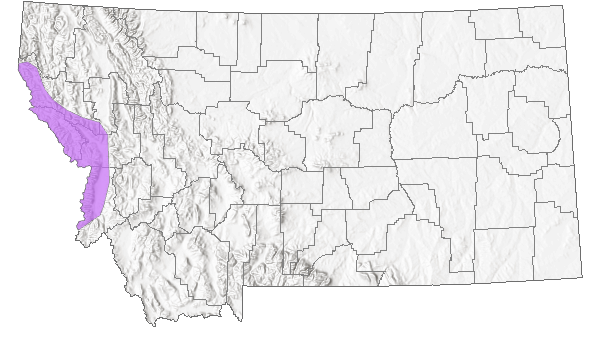
 Native
Native
Range Comments
British Columbia to California, east to northern Idaho and northwestern Montana. Peripheral.
Observations in Montana Natural Heritage Program Database
Number of Observations: 53
(Click on the following maps and charts to see full sized version)
Map Help and Descriptions
Relative Density
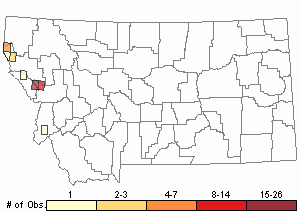
Recency
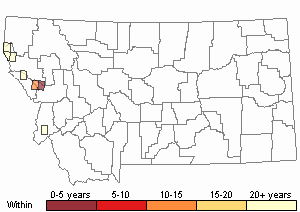
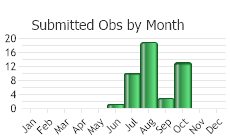
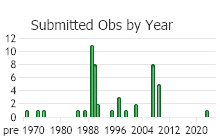
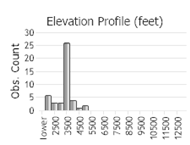 (Observations spanning multiple months or years are excluded from time charts)
(Observations spanning multiple months or years are excluded from time charts)
Habitat
Partial or deep shade of moist forests in the montane zone, sometimes in second growth.
National Vegetation Classification System Groups Associated with this Species
Forest and Woodland
Montane - Subalpine Forest and Woodland
Ecology
POLLINATORS The following animal species have been reported as pollinators of this plant species or its genus where their geographic ranges overlap:
Bombus vagans (Colla and Dumesh 2010).
Stewardship Responsibility
Threats or Limiting Factors
STATE THREAT SCORE REASON
Threat impact not assigned because threats are not known (MTNHP Threat Assessment 2021).
References
- Literature Cited AboveLegend:
 View Online Publication
View Online Publication Colla, S.R. and S. Dumesh. 2010. The bumble bees of southern Ontario: notes on natural history and distribution. Journal of the Entomological Society of Ontario 141:39-68.
Colla, S.R. and S. Dumesh. 2010. The bumble bees of southern Ontario: notes on natural history and distribution. Journal of the Entomological Society of Ontario 141:39-68. MTNHP Threat Assessment. 2021. State Threat Score Assignment and Assessment of Reported Threats from 2006 to 2021 for State-listed Vascular Plants. Botany Program, Montana Natural Heritage Program, Helena, Montana.
MTNHP Threat Assessment. 2021. State Threat Score Assignment and Assessment of Reported Threats from 2006 to 2021 for State-listed Vascular Plants. Botany Program, Montana Natural Heritage Program, Helena, Montana.
- Additional ReferencesLegend:
 View Online Publication
View Online Publication
Do you know of a citation we're missing? Gill, L. S. 1981. Biosystematics of the tribe Satureineae (Labiatae) in Canada II. Cytologia 46:45-55.
Gill, L. S. 1981. Biosystematics of the tribe Satureineae (Labiatae) in Canada II. Cytologia 46:45-55. Lawrence, B.M. and A.C. Bromstein. 1974. Terpenoids in Satureja douglasii. Phytochemistry 13:1014.
Lawrence, B.M. and A.C. Bromstein. 1974. Terpenoids in Satureja douglasii. Phytochemistry 13:1014. Lesica, P., M.T. Lavin, and P.F. Stickney. 2012. Manual of Montana Vascular Plants. Fort Worth, TX: BRIT Press. viii + 771 p.
Lesica, P., M.T. Lavin, and P.F. Stickney. 2012. Manual of Montana Vascular Plants. Fort Worth, TX: BRIT Press. viii + 771 p. Lesica, P., M.T. Lavin, and P.F. Stickney. 2022. Manual of Montana Vascular Plants, Second Edition. Fort Worth, TX: BRIT Press. viii + 779 p.
Lesica, P., M.T. Lavin, and P.F. Stickney. 2022. Manual of Montana Vascular Plants, Second Edition. Fort Worth, TX: BRIT Press. viii + 779 p.
- Web Search Engines for Articles on "Yerba Buena"





